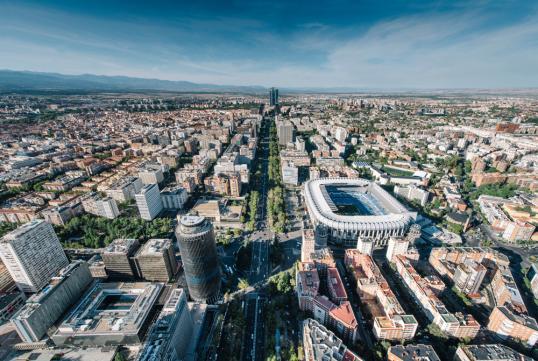- Topic
- Urban mobility planning
- Country
- Spain
- Resource type
- Case study
First published on 18 October 2022.
Madrid was nominated as a finalist of the 10th SUMP Award in 2022, due to its latest Madrid 360 Plan that includes ambitious goals and detailed key performance indicators until the year 2030. The city was invited to the EUROPEANMOBILITYWEEK award ceremony along the two other finalists of Mitrovica South (KO) and Tampere (FI), which was selected as the winner of 2022.
Context
Madrid is home to more than 3.4 million inhabitants and is located in the centre of Spain. More than 2.2 million international overnight tourists can use 13 metro lines, more than 170 bus lines and 3 light rail lines to get around the city. Whether they are attending a match of Real Madrid Football Club or use the Spanish capital as a start of their travel to other regions in Spain like Andalucia or Catalonia, the urban, regional and national public transport network is well-developed. In fact, ‘Metro de Madrid’ alone registered 447,82 million trips in 2021. Furthermore, the capital region of Madrid generates around 20% of the national GDP output – similar figures to Catalonia. Thus, the entire region is a strong economic motor due to its service industry, tourism and the jobs generated by the Spanish government. Therefore, employees are commuting into the city on a daily basis.
In action
The main action points that led to the nomination as a finalist of the 10th SUMP Award was the ambitious Madrid 360 Mobility Plan, which aims to extend public transport offers, improve infrastructure, improve road safety, promote active mobility and review parking management – all within seven years between 2023 and 2030. The ambitious goals are: halving the number of fatalities, reducing CO2 emissions and congestion by 65% and 46% respectively, and lowering vehicle kilometres travelled by 23%.
The reduction in road fatalities and increases in road safety shall be achieved with a stronger focus on speed reduction and enforcement of the 30km/h speed limit, which has already been established. All one-lane streets have a speed limit of 30km/h and larger roads are divided into a separate intermodal lane with 30km/h maximum speed. Additionally, awareness-raising campaigns for pupils, students and adults are organised, and the underaged are obliged to wear a helmet.
According to the slogan of 2021’s EUROPEANMOBILITYWEEK campaign “Safe and Healthy with Sustainable Mobility", a significant aspect of the ‘Madrid 360 Plan’ SUMP is health-related. It includes the promotion of public transport and cleaner vehicles among other topics. The first focus will be achieved by:
- Investing in the bus fleet overhaul by increasing zero emission busses and by implementing smart bus lines;
- Improving the (sub-)urban rail and metro network;
- Modal integration of micro-mobility and the promotion of intermodality.
Furthermore, the shift towards of cleaner vehicles will be achieved with the following aims:
- Transformation of public vehicle fleet technology;
- Promote the technological change of urban goods distribution vehicles;
- Facilitating the location of logistics centres;
- Create a parking space management and control system for loading and unloading;
- Promote the installation of e-commerce distribution counters in parking.
Results
Several concrete aims have been defined within the latest SUMP framework. These include intermodal axes and key performance indicators (KPIs) for cycling, micromobility and ridesharing:
- Execution of new intermodal axes in the city centre that promote multimodality around important areas of the city (such as the Prado Museum).
- Collaboration mechanisms with shared mobility companies (carsharing, bike-sharing), for up to 20,000 new personal mobility vehicles (PMVs) by 2030.
- Completion of the cycling network with 250 new kilometres of bike paths and 20,000 parking lots for bikes by 2030.
- Increasing the service of private bike-sharing operators for up to 10,000 bicycles by 2030.
- Increasing the number of lots for shared bikes up to 30,000 by 2030.
- Creation of up to 2,000 parking lots for car-sharing and car-pool vehicles by 2030.
- Construction of intermodal car parks in the municipality of Madrid (10,000 lots).
Even though these numbers have not been achieved (yet), one can observe that Madrid has an ambitious plan that goes far beyond a standard SUMP, especially focussing on active- and shared mobility (which was pointed out positively by the jury).
Challenges, opportunities and transferability
One of the main challenges are the previously mentioned ambitious goals, which might be arduous to achieve, if the endeavour is not supported by the user base. Furthermore, as Madrid has seen in projects like MOMENTUM, the micromobility and sharing sector is extremely volatile. The construction of intermodal car parks across the Madrid municipality also counteracts the trend of reducing parking spaces in urban areas.
One significant aspect that can be transferred is the ambition of Madrid to define clear KPIs that identify clear commitments by avoiding vague language. Furthermore, the presented aspects in Madrid’s SUMP are not focusing on containing passenger car traffic - offers for shared mobility solutions and active mobility offers are added to entice users away from the car.
In Depth
Contact: Mrs. Lola Ortiz Sánchez

